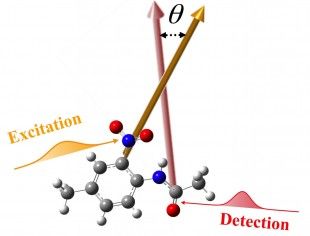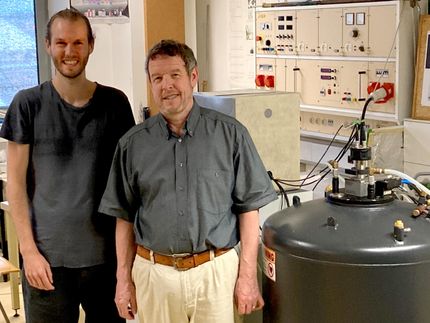Spectrometer reads vibrations between atoms
A Rice University laboratory has improved upon its ability to determine molecular structures in three dimensions in ways that challenge long-used standards.

A technique by Rice University chemist Junrong Zheng measures vibrations between atoms to determine the three-dimensional form of molecules.
Zheng Lab/Rice University
By measuring the vibrations between atoms using femtosecond-long laser pulses, the Rice lab of chemist Junrong Zheng is able to discern the positions of atoms within molecules without the restrictions imposed by X-ray diffraction (XRD) and nuclear magnetic resonance (NMR) imaging.
The technique can capture the structure of molecules at room temperature or very low or high temperatures and in many kinds of samples, including crystals, powders, gels, liquids and gases. It will be useful to scientists who study catalysis, energy storage, organic solar cells and biomembranes, among many other possibilities, Zheng said.
The researchers reported their results online in the American Chemical Society’s Journal of Physical Chemistry.
Zheng and his co-authors at Rice and Oak Ridge National Laboratory analyzed variations of a model molecule, 4′-methyl-2′nitroacetanilide (MNA), and compared the results with computer-generated and XRD models. The images matched nicely, he said.
Traditional spectrometers read the wavelengths of light scattered by samples to identify materials and study their properties. But the one-of-a-kind spectrometer developed by Zheng uses very short laser pulses to read the vibrational energies inherent to every atom. Those energies determine how atoms bond to form a molecule, and a measurement of the length and angles of those bonds can be extracted from the vibrations themselves, he said.
The infrared and terahertz lasers used for the experiment captured information about a molecular angle in a mere 100 femtoseconds. (One femtosecond is a millionth of a billionth of a second.)
“The important part of this paper is to demonstrate that our method can determine three-dimensional molecular structures no matter whether they’re in liquids or solids,” Zheng said.
“Typically, when organic chemists synthesize a molecule, they know its makeup but have no idea what the structure is,” he said. “Their first option is to make a single crystal of the molecule and use XRD to determine the precise structure. But in many cases it’s very tedious, if not impossible, to grow a single crystal.
“People also use NMR to learn the structure,” he said. “But the trouble with many molecules is the solubility is really bad. Insoluble molecules can’t be read well by either method.”
The Rice technique, dubbed “multiple-dimensional vibrational spectroscopy,” is able to capture the conformation of small molecules — for starters — with great accuracy, Zheng said. The spectrometer reads only intramolecular interactions among vibrations and ignores interactions between molecules, he said.
“The atoms in every molecule are always vibrating, and each bond between atoms vibrates at a certain frequency, and in a certain direction,” he said. “We found that if we can measure the direction of one vibration and then another, then we can know the angle between these two vibrations – and therefore the angle between the bonds.”
He said the researchers begin with the chemical formula and already know, through Fourier transform infrared spectroscopy, how many vibrational frequencies are contained in a given molecule. “Then we measure each vibrational mode, one by one. Once we get all the cross-angles, we can translate this to a model,” he said.
For now, as a proof of concept, Zheng and his team analyze molecules for which the structure is already known. Over time, the technique should be able to analyze much larger molecules, like viruses that contain thousands or tens of thousands of atoms, he said.
“This is just the first demonstration that this method works,” he said. “These are simple molecules, 23 or 24 atoms. I think it will take some time to get to proteins. My expectation is that it will take 10 to 20 years to develop. Remember, for NMR, it took 50 years to be able to read the structure of proteins.”
Other news from the department science
Most read news
More news from our other portals
See the theme worlds for related content
Topic World Spectroscopy
Investigation with spectroscopy gives us unique insights into the composition and structure of materials. From UV-Vis spectroscopy to infrared and Raman spectroscopy to fluorescence and atomic absorption spectroscopy, spectroscopy offers us a wide range of analytical techniques to precisely characterize substances. Immerse yourself in the fascinating world of spectroscopy!

Topic World Spectroscopy
Investigation with spectroscopy gives us unique insights into the composition and structure of materials. From UV-Vis spectroscopy to infrared and Raman spectroscopy to fluorescence and atomic absorption spectroscopy, spectroscopy offers us a wide range of analytical techniques to precisely characterize substances. Immerse yourself in the fascinating world of spectroscopy!






























































